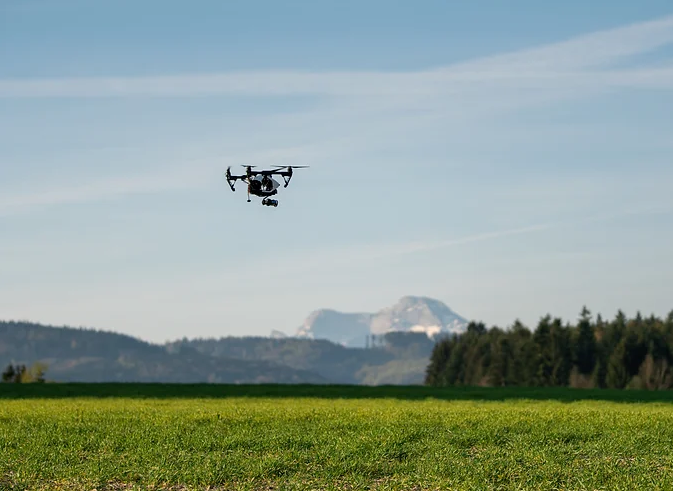Advancements in Autonomous Drone Technology: Revolutionizing the Skies
- Varshini R
- Jul 2, 2023
- 4 min read
Autonomous drone technology has advanced to unprecedented heights, revolutionizing aeromodelling and altering industries worldwide. These drones are capable of autonomous navigation and intelligent decision-making thanks to enhanced sensors, AI algorithms, and machine learning capabilities. In this blog article, we will look at the most recent breakthroughs in autonomous drone technology and how they are transforming many industries. Join us on a trip to discover the potential of these autonomous flying aircraft, from obstacle avoidance to computer vision.
Enhancing Safety and Efficiency: The Role of Obstacle Avoidance in Autonomous Drones
Obstacle avoidance is a pivotal aspect of autonomous drone technology, playing a crucial role in enhancing security and efficiency. With the integration of cutting-edge sensors such as LiDAR and radar, coupled with sophisticated algorithms, drones can detect and navigate around obstacles in real time. This breakthrough capability significantly reduces the risk of collisions and accidents during aerial operations, ensuring the safety of both the drone and its surroundings. By seamlessly maneuvering through diverse environments and avoiding potential hazards, autonomous drones can efficiently carry out a wide range of tasks, including critical infrastructure inspections, search and rescue missions, and package delivery in bustling metropolitan areas. This not only saves time and resources but also opens up new possibilities for industries to utilize drones in various applications, knowing that they can operate safely and effectively in complex and dynamic environments. Overall, obstacle avoidance technology is revolutionizing the way drones operate, paving the way for safer, more secure, and highly efficient aerial operations across industries.
Advancing Autonomy: Unleashing the Power of Advanced AI Algorithms in Autonomous Drones
Advanced AI algorithms play a pivotal role in the realm of autonomous drone technology, taking autonomy to new heights. These algorithms enable drones to go beyond reactive decision-making and venture into the realm of predictive autonomy. By leveraging powerful AI systems, drones can analyze vast amounts of real-time data, allowing them to make informed decisions based on patterns and trends. With machine learning capabilities, autonomous drones can adapt to changing environments, optimize flight trajectories, and even anticipate potential threats. This advancement in AI algorithms enhances operational efficiency, expands the range of capabilities, and opens up possibilities for complex tasks such as autonomous mapping and 3D modeling. With each iteration and improvement, AI algorithms propel autonomous drones towards higher levels of intelligence and autonomy, unlocking new frontiers in various industries.
Visual Perception Unleashed: Exploring the Potential of Computer Vision in Autonomous Drones
Computer vision is a fundamental component of autonomous drone technology, revolutionizing the way drones perceive and interact with their environment. By harnessing computer vision techniques, drones can autonomously recognize and track objects in real-time. This capability enables a wide range of applications, including automated infrastructure inspection, precision agriculture, and wildlife monitoring. Equipped with computer vision, drones can detect and analyze visual cues, identifying objects, structures, or anomalies with high accuracy. This valuable insight obtained through computer vision enhances operational efficiency and streamlines tasks in various industries. From identifying fractures in buildings to monitoring crop conditions, autonomous drones equipped with computer vision capabilities empower industries with invaluable visual intelligence, paving the way for more efficient and effective operations.
Collective Intelligence Soaring: The Significance of Swarm Intelligence in Autonomous Drones
Swarm intelligence is a groundbreaking advancement in autonomous drone technology that enables collaborative aerial operations. By forming a cohesive swarm, drones can communicate, interact, and work together as a unified group. This collective intelligence allows drones to share information, coordinate actions, and solve complex tasks that would be challenging or impossible for a single drone to accomplish alone. Swarm intelligence enhances the efficiency and effectiveness of various operations, such as search and rescue efforts, surveillance missions, and even entertainment presentations. By leveraging swarm intelligence, autonomous drones can achieve higher levels of coordination, adaptability, and scalability, revolutionizing the capabilities and possibilities of aerial operations in numerous industries.
Expanding Horizons: Beyond Line of Sight (BLOS) Operations in Autonomous Drones
Beyond Line of Sight (BLOS) operations represent a significant advancement in autonomous drone technology, expanding the horizons of aerial operations. Traditionally, drones were limited to operating within the visual range of the pilot or ground station. However, with the aid of advanced communication technologies like satellite links and cellular networks, autonomous drones can now operate beyond the visible range. This capability opens up new opportunities for applications in remote locations, disaster zones, and offshore operations. Drones can perform effective monitoring, data collection, and response in previously inaccessible or challenging environments. BLOS operations enable enhanced situational awareness, extended operational range, and the ability to gather crucial data and perform critical tasks in remote or hazardous areas, ultimately transforming the way drones are utilized in industries such as environmental monitoring, infrastructure inspections, and emergency response.
Transforming Industries: Applications and Impact of Autonomous Drones in Various Sectors
The advancements in autonomous drone technology have brought about transformative applications across various industries. These applications leverage the improved situational awareness and efficiency provided by autonomous drones. In surveillance and security operations, autonomous drones offer enhanced capabilities for monitoring and maintaining safety. Delivery businesses are exploring the use of autonomous drones for faster and more precise deliveries. Industries such as agriculture, filmmaking, and infrastructure inspection are utilizing autonomous drones to improve efficiency and accuracy in tasks such as crop monitoring, capturing cinematic shots, and inspecting infrastructure for maintenance and safety purposes. These examples showcase the enormous potential of autonomous drone technology in revolutionizing industries and opening up new possibilities for increased productivity, safety, and cost-effectiveness.
Conclusion
Autonomous drone technology breakthroughs are boosting the aeromodelling business to new heights. These drones are changing the way we see airborne operations, from obstacle avoidance and advanced AI algorithms to computer vision and swarm intelligence. The potential of autonomous drones is broad and exciting, with applications in surveillance, delivery services, agriculture, and other fields. As technology advances, we may expect even more ground-breaking breakthroughs that will push the frontiers of what these autonomous flying aircraft can achieve in the skies of tomorrow.

















1 Comment